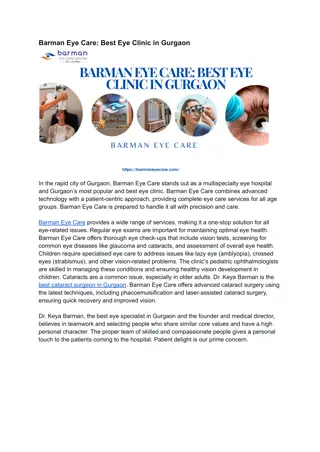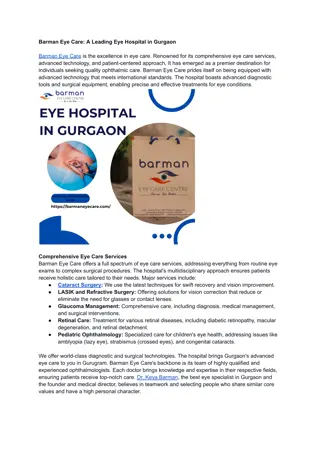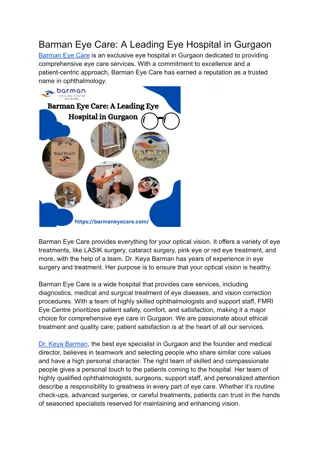Understanding the Importance of Eye Banking
Explore the significance of eye banking, learn about the history, surgical procedures, and key milestones in the field. Understand the need for eye banks in preserving vision, treating diseases, and supporting corneal transplants. Discover how early intervention can prevent devastating eye injuries. Images and learning objectives enhance comprehension.
Download Presentation

Please find below an Image/Link to download the presentation.
The content on the website is provided AS IS for your information and personal use only. It may not be sold, licensed, or shared on other websites without obtaining consent from the author. Download presentation by click this link. If you encounter any issues during the download, it is possible that the publisher has removed the file from their server.
E N D
Presentation Transcript
EYE BANKING Dr.Ajai Agrawal Additional Professor Department of Ophthalmology A.I.I.M.S. RISHIKESH
Acknowledgment Photographs in this presentation are courtesy of Dr. Samar. K. Basak
Learning Objectives At the end of the class, students shall be able to Understand the importance and need of eye banking Have basic knowledge of structure and functions of eye banks Understand the various surgical procedures for corneal transplantation
History 1903: E. Zirm(Czechoslovakia) performed 1st successful human corneal transplantation. 1935: V P Filatov (Russia): Father of keratoplasty and modern eye banking. 1944: Dr. R. Townley Paton established the first eye bank in New York City. 1945: The first eye bank in India was started in Regional Institute of Ophthalmology, Chennai.
1960 : 1stsuccessful corneal transplantation in India by Dr. Dhanda (Indore). 1974: McKarey and Kaufman developed M- K medium which allowed the excised corneo-scleral rim to be preserved for up to 4 days at 4 C. 1985: Kaufman et al. presented K-Sol as a storage method viable for up to 10 days. 1989: Eye Bank Association of India was formed.
Injuries Open globe injuries Chemical injuries Can be devastating Need early intervention
Eye Bank is a non profit organization which deals with the collection, storage and distribution of the donor cornea for the purpose of corneal grafting, research and supply of eye tissues to other eye banks for ophthalmic purposes.
Structure of Eye Bank Medical section : Medical Director ( A qualified Corneal Surgeon), Trained technicians Administrative Section: Eye Donation Counsellor / Social Worker / Health Educator / Clerk
Functions of the Administrative Section The administrative section is responsible for - Public awareness programmes - Liaison with government, local voluntary and other health care agencies - Fund raising
Functions of the Medical Section Medical section deals with the entire technical operation of the eye bank: -Tissue harvesting, evaluation, preservation and distribution (maintaining medical quality of highest standard).
Functions of the Eye Bank Networking of eye banks under the umbrella of a national organisation ( e.g. Eye Bank Association of India) allows -Public education programmes - Institution of newer eye banking procedures - Training programmes and development of uniform medical standards
Eye Banking System Eye Donation Center (EDC) affiliated to a registered eye bank (1) public and professional awareness about eye donation (2) co-ordinate with donor families and hospitals to motivate eye donation (3) to harvest corneal tissue and collect blood for serology (4) to ensure safe transportation of tissue to the parent eye bank.
Eye Bank (EB) Provide a round-the-clock public response system over the telephone and conduct public awareness programs on eye donation. Co-ordinate with donor families and hospitals to motivate eye donation/Hospital Cornea Retrieval Programs (HCRP) To harvest corneal tissue To process, preserve and evaluate the collected tissue To distribute tissue in an equitable manner for Keratoplasty To ensure safe transportation of tissue Eye Bank Training Centre (EBTC) All of the eye bank functions plus training for all levels of personnel in eye banking and research.
Equipments EBTC Required EQUIPMENTS Slit lamp EB EDC Required Not required Refrigerators Required Required Preferable Serology Required Required Not required Specular microscope Required Required if collection is 200/yr Required Not required Instruments for corneal excision Required Required Autoclave Required Required Should have access Required Laminar flow hood Required Required
How It Works ? Recovery or retrieval Cornea Processing Distribution
Deceased family calls Eye Bank Grief counselor motivates and obtains consent Retrieval/ Recovery of tissue
Tissue Retrieval Contraindications: Systemic: AIDS Rabies Active viral hepatitis Creutzfeldt-Jakob disease SSPE Reye s syndrome Death from unknown causes Congenital Rubella Active septicemia Leukemia (blast form) Lymphoma/lymphosarcoma Ocular: Intrinsic eye diseases Retinoblastoma Active conjuctivitis,iritis,uveitis, vitritis,retinitis Congenital abnormalities (keratoconus) Central opacities,pterygium Prior refractive procedures (radial keratotomy)
Preliminary preparations Obtain legal permission. Go through the donor s medical records for any contraindications. Wash hands and be prepared with aseptic dressing. Identify the donor. Collection of postmortem blood:10ml Femoral vein Subclavian vein Heart Jugular vein
Serological testing HIV HBV HCV Syphilis
Evaluation of donor tissue Gross examination Whole globe: eyes with excessive stromal hydration should be discarded unless specular microscopy can be done for endothelial cell count. Corneoscleral button: Colour of the tissue storage media is to be noted to rule out contamination.
Evaluation of donor tissue Slit Lamp Biomicroscopic examination
Endothelial cell count AGE Average Endothelial cell count 10-19 2,900-3,500 Critical cell density: 300-500 cells/mm2 Functional cell density: 1500-2200 cells/mm2 20-29 2,600-3,400 30-39 2,400-3,200 40-49 2,300-3,100 50-59 2,100-2,900 60-69 2,000-2,800 70-79 1,800-2,600 80-89 1,500-2,300 * Philips C, Laing R, Yee R. Specular Microscopy. In: Krachmer JH, Mannis MJ, Holland EJ (eds). Cornea, 2nd ed. Philadelphia: Elsevier Mosby, 2005:261-77.
Exclusion Criteria for penetrating keratoplasty* Cell density less than 2000 cells per square millimeter. (Corneas with cell density less than 2000 cells / sq. mm may be suitable for lamellar procedures). Extreme polymegathism or pleomorphism. Presence of significant guttata. Presence of many non-hexagonal or abnormally shaped cells. Presence of inflammatory cells, bacteria, or debris on endothelial surface. Numerous vacuolated cells. *Standards of Eye banking in India 2009;NPCB;Director General of Health & Family Welfare, Govt. of India
Storage of donor tissue Storage Long term 30days Organ culture medium, MEM Short term 2-3days Moist chamber (24hrs) M-K medium Intermediate 7-10days K-sol, Dexsol,Optisol, Optisol GS Very long term 1year Cryopreservation
Preservation of cornea Moist chamber storage Storage of whole globe 4 C 24 hours Advantage: Simple Disadvantage: Corneal stromal edema.
Preservation of cornea Tissue Media o Dextran o Chondroitin sulphate o Electrolytes o pH buffer system o Antibiotics o Essential amino acids o Antioxidants,ATP precursors o Insulin o Epidermal growth factor o Antiprotease,anticoagulants Cornea storage Media Storage time (days) MK 4 K-SOL 7 CSM 7 DEXSOL 10 OPTISOL 14 PROCELL 14
M-K medium: Described by Mc-Carey & Kauffman. Mixture of tissue culture medium (TC-199) and Dextran (5%,40,000 MW) Buffer: HEPES (N hydroxyethyl- piperazine-N-ethane Sulphonic acid) Antibiotics:Penicillin,Gentamicin,Polymyxin Storage period- 96hrs. K-Sol: Purified chondroitin sulphate in tissue culture medium (TC 199). Storage:7-10days in 40 C.
Preservation of cornea Long term Organ Culture storage system MEM media(minimum essential media) Developed by Harry Eagle. 34 degree C Incubated at room temperature in nutrient medium Storage period : 30 days Advantage: Enables HLA matching Very long time preservation: Cryopreservation 1year
Cornea as transplant Immune privilege of cornea Absence of blood and lymphatic channel in the graft and its bed Absence of MHC class II APCs in the graft Reduced expression of MHC coded alloantigen on graft cells Immunosupressive microenvironment of aqueous humor. Anterior chamber associated immune deviation.
Corneal Transplantation Corneal transplantation refers to surgical replacement of a full-thickness or lamellar portion of the host cornea with that of a donor eye. Allograft/autograft Full-thickness( Penetrating)/ Partial thickness ( lamellar)
Types of Keratoplasty Optical to improve vision Tectonic- to restore or preserve corneal integrity Therapeutic- to remove infected corneal tissue Cosmetic- to improve appearance























